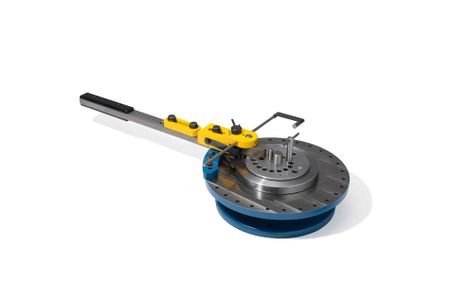Difference between revisions of "Hand Bender"
Ddemaree17 (talk | contribs) |
Ddemaree17 (talk | contribs) |
||
| Line 42: | Line 42: | ||
See the diagram on page 4 of the [https://maker-hub.georgefox.edu/w/images/0/04/Di-Acro_Hand_Bender.pdf User Manual] for complete terminology and visual reference. | See the diagram on page 4 of the [https://maker-hub.georgefox.edu/w/images/0/04/Di-Acro_Hand_Bender.pdf User Manual] for complete terminology and visual reference. | ||
| − | * Radius pin - The dye that the stock is formed around measured by | + | * Radius pin - The dye that the stock is formed around measured by its radius. |
** The following sizes are available in the maker-hub: 1/8", 3/16", 1/2", 11/16", 1", 1 3/4". | ** The following sizes are available in the maker-hub: 1/8", 3/16", 1/2", 11/16", 1", 1 3/4". | ||
* Locking pin - A cam pin used to lock the material against the radius pin. Depending on the application, using a holding pin instead of a locking pin may be easier. | * Locking pin - A cam pin used to lock the material against the radius pin. Depending on the application, using a holding pin instead of a locking pin may be easier. | ||
Revision as of 08:37, 21 May 2020
Make: Di-Acro
Model: Model 2 Bender (02HB)
Ace: Needed (Makerhub@georgefox.edu).
Location: Machine Shop
Description
A hand bender is a machine used to bend wire, solid stock, and tubing. The bender comes with multiple dyes for different types of bends.
*Currently the bender stand is not bolted to the floor, so you can really only bend light materials like 1/8" thick aluminum. If you want to bend thicker material, you will need help from someone to hold the table. In the future we will be bolting the bender to a sturdier spot.
Here is an example of bending a piece of rod:
Here is an example of bending a piece flat bar:
Documentation
Terminology
See the diagram on page 4 of the User Manual for complete terminology and visual reference.
- Radius pin - The dye that the stock is formed around measured by its radius.
- The following sizes are available in the maker-hub: 1/8", 3/16", 1/2", 11/16", 1", 1 3/4".
- Locking pin - A cam pin used to lock the material against the radius pin. Depending on the application, using a holding pin instead of a locking pin may be easier.
- Holding pin - A pin used to brace the material against the radius pin. A holding pin may be used when there is enough material behind the desired bend to brace against the holding pin.
- Handle - The thing you grab to gain mechanical advantage and exert force on the material.
- Forming nose - The contact point between the handle and the material.
- Trigger - The lever- esc thing on top of the handle responsible for bracing the forming nose against bending in a particular direction. The lever should always point in the direction that the handle is being pulled.
- Adjusting Bolt - NOT a technical term, used instead of "SCREW-HHCS 1/2-20X2". For the purposes of explaining how to use the hand bender, the adjusting bolt refers to the bolt that you loosen to adjust the distance between the forming nose is to the radius pin. See #27 on the figure on page 4 of the User Manual
Training
Overview
Read/skim the "Art of Bending" document to find out how to set up the equipment. Then Watch the "Simple Bend" video to see how the equipment functions.
Demonstration
To demonstrate competency on the hand bender you will be required to make a s hook.
General Procedure
1) Gather all necessary supplies: 0.25" round mild steel stock, ruler, sharpie, hacksaw, 1/2" R radius pin, locking pin, 3/4" wrench.
2) Cut a piece of 0.25" round mild steel stock 6" long using a hacksaw. (A hacksaw should be used instead of the horizontal band-saw because the diameter of the material being cut is small enough that only one-two teeth on the band-saw blade will contact the material at a given time. The likelihood of damaging the saw blade or having the stock become caught in the blade increases anytime less than three teeth are in contact with the cut stock.)
3) Using a ruler and sharpie, mark the middle point and make a mark 1/8" from each end respectively.
4) Insert the 1/2" R radius pin into the center hole and place the locking pin in the 2nd closest hole.
5) Insert the 6" rod between the radius pin and the die and tighten the cam such that the 1/8" mark is tangent to the die. It is a tight fit so rocking the radius pin back and forth may be necessary to adjust properly.
6) As needed, use the 3/4" wrench adjust the adjusting bolt such that the locking pin does not interfere with the path of the forming nose. The middle position should work.
7) Bend the rod until the center mark on the rod barely touches the radius pin. The rod will spring back so a slight over-bend is necessary.
Safety
- Keep all hands and fingers out of any pinch points.
- Be aware of your surroundings before swinging the bending handle.
Certification
Troubleshooting
This is a very basic piece of equipment so very little trouble shooting should be required. See the "Art of Bending" document for machine setup.
Maintenance
General maintenance
Tech will lubricate zerk fitting as needed.
Specific Maintenance Tasks
| Maintenance Procedure | Frequency | Done By |
|---|---|---|
| Sample | Sample | Sample |
